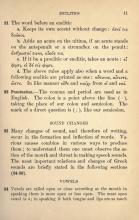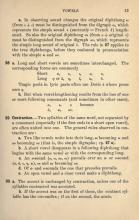24. Vowels are called open or close depending upon whether the mouth in speaking them is more open or less open. The most open vowel is ᾱ; in speaking it both tongue and lips are as much as possible out of the way. In ῑ the tongue narrows the opening; its edges lie close to the teeth, the breath issuing along the middle. In ου the lips are rounded so as to narrow the opening, while the tongue is drawn back. In ῡ the opening is narrowed by the tongue as for ῑ and by the lips as for oυ. Thus ῑ, ῡ, and ου are the closest vowel sounds. Between ᾱ and ῑ are η, ε, and ει; between ᾱ and oυ are ω and o. These relations are suggested in the following table:
25. The short open vowels (α, ε, ο) often interchange, in root, stem, suffix, and endings. To indicate this variable sound, changing from one to another in various forms, we use the symbols ο:ε, α:ε, and α:ε:ο.
26. In like manner the long open vowels (ᾱ, η, ω) often interchange. The pair ᾱ:η is especially frequent in declension, the pair η:ω in conjugation.
a. Less often one of the short open vowels interchanges with one of the long open vowels. Instances are noted as they occur.
27. Originally υ represented the sound that was afterward written ου. The two close vowels, ι and original υ, when followed by a vowel, became consonantal, like our consonants y and w respectively; the same change occurred in Latin, and often occurs in English. The earliest Greek had these two consonants; the latter survived in some dialects in the classical period, and was represented by ϝ, called vau, or (from its shape) δί-γαμμα digamma. But in Attic both had disappeared before 500 B. C. Thus arises the rule: The close vowels ι and υ often disappear between two vowels. See § 135.
a. In observing sound changes the original diphthong ει (from ε + ι must be distinguished from the digraph ει, which represents the simple sound ε (anciently = French é) lengthened. So also the original diphthong ου (from ο + original υ) must be distinguished from the digraph ου, which represents the simple long sound of original ῡ. The rule in § 27 applies to the true diphthongs, before they coalesced in pronunciation with the simple ει and ου.
28. a. Long and short vowels are sometimes interchanged. The corresponding forms are commonly
| Short | α | ε | ι | ο | υ |
| Long | η or ᾱ | η | ῑ | ω | ῡ |
Tragic poets in lyric parts often use Doric ᾱ where prose uses η.
b. But when vowel lengthening results from the loss of one or more following consonants (and sometimes in other cases):
α ⇢ ᾱ
ε ⇢ ει
ο ⇢ ου



